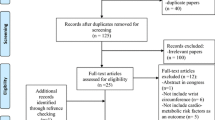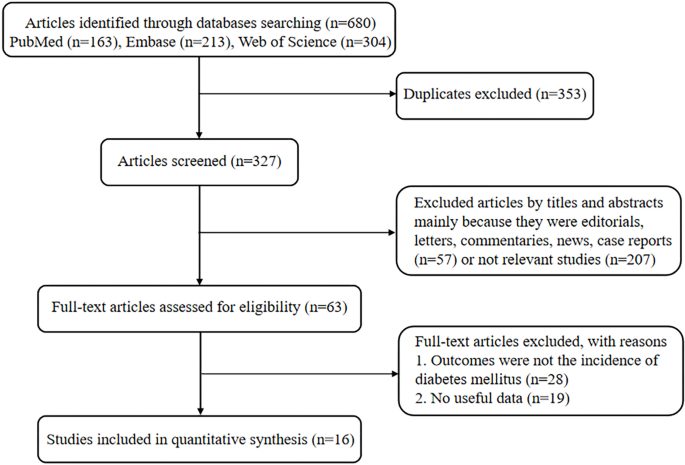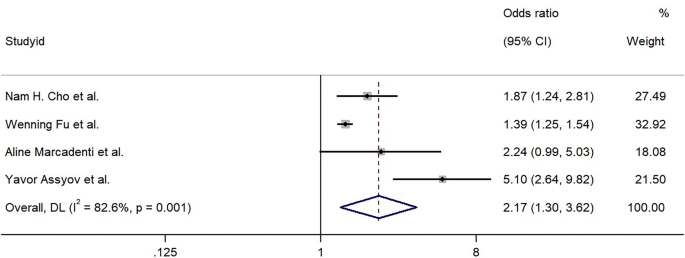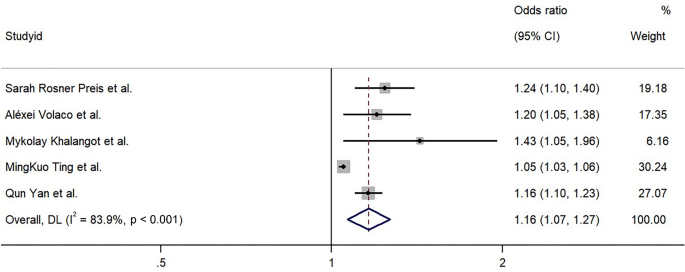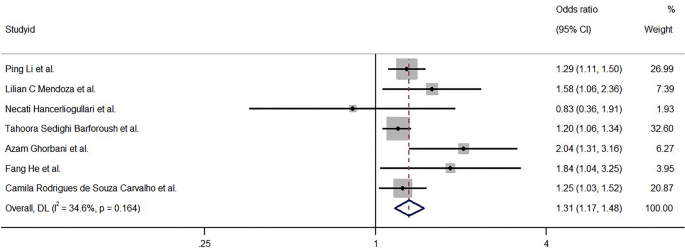Abstract
Background
Despite that several original researchers have investigated the association between neck circumference (NC) and the risk of diabetes mellitus (DM), their results remain controversial. This review aimed to quantitatively determine the risk of DM in relation to the NC.
Methods
We conducted a literature search of PubMed, Embase, and the Web of Science from these databases’ inception through September 2022 to identify observational studies that examined the association between NC and the risk of DM. A meta-analysis of the random-effects model was applied to combine the results of the enrolled studies.
Results
Sixteen observational studies involving 4,764 patients with DM and 26,159 participants were assessed. The pooled results revealed that NC was significantly associated with the risk of type 2 DM (T2DM) (OR = 2.17; 95% CI: 1.30–3.62) and gestational DM (GDM) (OR = 1.31; 95% CI: 1.17–1.48). Subgroup analysis revealed that after controlling for BMI, the relationship between the NC and T2DM remained statistically significant (OR = 1.94; 95% CI: 1.35–2.79). Moreover, the pooled OR of T2DM was found to be 1.16 (95% CI: 1.07–1.27) for an increment per each centimeter in the NC.
Conclusions
Integrated epidemiological evidence supports the hypothesis that a greater NC is associated with an increased risk of T2DM and GDM.
Similar content being viewed by others
Background
The incidence of diabetes mellitus (DM) has increased substantially in recent decades [1], which has imposed a heavy burden on healthcare systems. Knowledge of early markers to predict the disease and the adoption of related preventive strategies are of vital public health significance for improving this situation.
Obesity is a well-established risk factor for DM [2]. Several studies have suggested that total body obesity and abdominal obesity, which can be assessed based on body mass index (BMI), waist circumference (WC), and waist/hip ratio, could predict the risk of developing DM [3]. Recently, upper body subcutaneous fat has drawn the attention of researchers, and a study has shown that it may confer higher risks than visceral abdominal fat [4]. Furthermore, neck circumference (NC) has been considered as a proxy measure for upper body subcutaneous fat distribution [5]. Compared with other anthropometric indexes, NC measurement is more convenient, shows minimal fluctuations, and is not affected by respiratory conditions and diet. A meta-analysis [6] indicated that NC was moderately accurate in identifying overweight and obesity in children and adolescents, and another study [7] arrived at a similar conclusion in men and women of different age groups. Moreover, some studies have demonstrated that NC may be independently correlated with metabolic risk factors above and beyond BMI and WC [5, 8].
Over the past decades, numerous studies have assessed the relationship between NC and DM, but the results remain inconsistent. Some investigations have reported that NC has a direct relationship with DM [9,10,11], whereas others have shown that larger NC is not associated with the risk of DM [12, 13]. Considering the inconsistencies in the findings of existing studies, a systematic review and meta-analysis of observational epidemiological studies were performed to evaluate the association between NC and the risk of DM.
Methods
Literature search strategy
The present systematic review and meta-analysis were conducted in accordance with the Preferred Reporting Items for Systematic Reviews and Meta-Analysis (PRISMA) statement [14]. PubMed, Embase, and the Web of Science were searched from their inception until September 2022 using the following keywords with no restrictions to identify the relevant citations: ‘neck circumference’ in combination with ‘diabetes,’ ‘impaired glucose tolerance,’ ‘impaired fasting glucose,’ or ‘insulin resistance.’ The reference lists of the retrieved articles were also reviewed to identify any other pertinent studies.
Study selection
The studies were included in the meta-analysis if they met the following inclusion criteria: (i) the study design was cross-sectional, cohort or case-control, (ii) the odds ratio (OR) or relative risk (RR) with 95% confidence interval (CI) of DM incidence related to the NC were reported or could be calculated from the provided data. Abstracts, non-original papers (reviews, editorials, or letters), gray literature, unpublished studies, and studies providing data on the relationship between the NC and diabetes-led mortality or complications were excluded. If there was more than one report from the same study, we only included the report with the most detailed information for both NC and the outcome.
Data extraction
Two authors (D.L. and Y.Z.) independently extracted the following information from the included studies: first author, publication year, country or region, study design, age, sample size, the number of men and women, the cutoff point for NC, adjusted OR/RR with 95% CI, and the adjusted factors. The differences in data extraction between the two investigators were resolved via discussion with the third investigator (S.C.).
Quality assessment
We assessed the methodological quality of cohort and case-control studies with reference to the Newcastle–Ottawa Scale, which awards a score of 0–9 based on the selection of participants, comparability of the groups, and exposure/outcome assessment [15]. Studies scoring 0–3, 4–6, and 7–9 were categorized as low-, moderate-, and high-quality studies, respectively.
The assessment tool involving 11 items, as recommended by the Agency for Healthcare Research and Quality, was applied for cross-sectional studies [16]. The quality of the studies was first evaluated with reference to the established questions and then scored according to the following criteria: 1 point = if the item was considered in the study and 0 points = if the item was not considered or this aspect was ambiguous.
Each study was rated independently by two authors (D.L. and Y.Z.). Any disagreements were resolved via discussion with a third investigator (S.C.).
Statistical analysis
We considered OR as the common measure of association between the NC and the risk for DM. The reported RR was considered approximately as the OR. We calculated an overall pooled OR by using a random-effects model for the main analysis [17]. If studies reported results separately for different subgroups, we combined the subgroup estimates by using fixed-effect models before inclusion in the main meta-analysis. Q statistic with a significance level of < 0.10 and I2 statistic were applied to test the heterogeneity. The I2 statistic measures the percentage of total variation across studies because of heterogeneity rather than because of chance. It was calculated according to the formula by Higgins [18]. Substantial heterogeneity is an I2 value of at least 50%. Sensitivity analyses and subgroup analyses were conducted to evaluate the influences of the study design and population characteristics on our results. All statistical analyses were conducted by using STATA statistical software version 13.0 (STATA Corp, College Station, Texas, USA). P values were two-sided with a significance level of 0.05.
Results
Study selection and evaluation
The results of the literature research and selection are illustrated in Fig. 1. Initially, we retrieved 163 citations from PubMed, 213 from Embase, and 304 from the Web of Science. After 353 duplicates were excluded, 327 citations were screened through titles and abstracts, of which 264 were excluded because they were reviews, editorials, letters, commentaries, news reports, case reports, or irrelevant studies. After assessing the full texts of the remaining 63 articles, we excluded 47 articles, as 28 of these did not study the relationship between NC and DM incidence while 19 did not provide useful data to calculate these parameters. Finally, 16 studies [4, 9,10,11,12,13, 19,20,21,22,23,24,25,26,27,28] were included (including seven cohort studies, one case-control study, and eight cross-sectional studies).
Study characteristics
The main characteristics of the 16 studies are summarized in Table 1. These studies were published between 2010 and 2022. The study samples ranged in size from 196 to 8,450, with a total of 26,159, while the number of cases of DM ranged from 29 to 2,068, with a total of 4,764. Of these studies on the relationship between NC and DM, nine were about type 2 DM (T2DM), and seven were about gestational DM (GDM). None of the studies focused on the risk of other types of diabetes in relation to the NC. The study locations were as follows: nine studies were from Asia, three from Europe, three from South America, and one from North America. In addition, the quality scores for the seven cohort studies ranged from 5 to 9, with an average score of 7.43 from a maximum of 9 (Table A.1). The quality score for one case-control study was 7 (Table A.2). The quality assessment scores for the eight cross-sectional studies ranged from 4 to 7, with a mean score of 5 from a maximum of 11 (Table A.3).
Results of the meta-analysis
Association between the NC and T2DM
The results from the random-effects model combining the ORs for the relationship of T2DM with NC are shown in Fig. 2. When compared with people with smaller NC, those with larger NC were at an increased risk for T2DM, and the pooled OR was 2.17 (95% CI: 1.30–3.62). Substantial heterogeneity was observed (I2 = 82.6%, P = 0.001).
Two studies [4, 19] evaluated the risk of T2DM for per standard deviation increment in the NC, and the OR with 95% CI was 1.70 (95% CI: 1.35–2.13) and 2.06 (95% CI: 1.71–2.49), respectively. Three other studies [11, 21, 26] reported the risk of T2DM per 1-cm increase in the NC, and the OR with 95% CI was 1.43 (95% CI: 1.05–1.96), 1.05 (95% CI: 1.03–1.96), and 1.16 (95% CI: 1.10–1.23), respectively. We standardized the two results reporting OR per standard deviation increment in the NC to the form of OR per 1-cm increment and calculated the pooled OR by using a random-effects model. The pooled OR of T2DM for an increment per each centimeter in the NC was 1.16 (95% CI: 1.07–1.27), with substantial heterogeneity across studies (I2 = 83.9%, P < 0.001) (Fig. 3).
Results of sensitivity analyses and subgroup analyses
To identify the potential influence of a single study on the pooled results, any single study was excluded in turn and the results of the remaining included studies were pooled. The pooled OR did not materially change and ranged from 1.55 (95% CI: 1.22–1.99) to 2.71 (95% CI: 1.43–5.14) (Fig. A1).
Table A.4 shows the results of subgroup analyses on the NC and T2DM risk. A larger NC was found to be associated with an increased risk for T2DM in most subgroups. Subgroup analysis by the state revealed that the participants from South America and Europe had a higher risk of T2DM, and the highest point estimate was recorded for Europe (OR = 5.10, 95% CI: 2.64–9.82). The difference in the pooled OR among these three groups showed statistical significance (P = 0.003). Subgroup analysis by controlling for age also indicated a statistically significant difference in results (P = 0.001). No significant difference was detected between the groups in terms of other variables. Notably, subgroup analyses by controlling for BMI indicated that the heterogeneity mainly arose from studies with unadjusted BMI (I2 = 93.2% for studies with unadjusted BMI and I2 = 0% for studies with adjusted BMI).
Association between the NC and GDM
The results from the random-effects model combining the ORs for the relationship between GDM and NC are depicted in Fig. 4. The pooled OR was 1.31 (95% CI: 1.17–1.48), and no significant heterogeneity was observed (I2 = 34.6%, P = 0.164).
Results of sensitivity analyses and subgroup analyses
The sensitivity analysis indicated that the results were unaffected by any single study, with the pooled OR ranging from 1.25 (95% CI: 1.16–1.40) to 1.36 (95% CI: 1.15–1.61) (Fig. A2).
Table A.5 demonstrates the results of subgroup analyses about the NC and GDM risk. Subgroup analyses by the study design, state, and the cut-off point for NC, whether controlling for age and controlling for BMI showed no statistically significant difference in the outcomes. Most subgroups indicated a positive and statistically significant relationship between the NC and an increased risk of GDM.
Discussion
NC, a novel anthropometric index, is considered a marker of subcutaneous fat distribution in the upper body and an independent predictor of metabolic disorders, such as glucose intolerance, hypertension, and fatty liver disease [29,30,31]. This systematic review and meta-analysis focused on the link between NC and the risk of DM. The investigation included 16 observational epidemiological studies involving 4,764 patients with DM and 26,159 participants. Pooled analysis revealed that NC was positively associated with the risk of DM. Specifically, compared with individuals who had smaller NC, those with larger NC had a 2.17 times increased risk of T2DM. Moreover, compared with pregnant women who had smaller NC, the risk of GDM was increased by 31% for those with larger NC.
Several potential mechanisms have so far been proposed to describe the relationship between NC and DM. First, NC is correlated positively with triglyceride levels and negatively with high-density lipoprotein cholesterol levels, both of which are robust markers for decreased insulin sensitivity [9, 32]. Additionally, larger NC with enhanced sympathetic activity may contribute to insulin resistance, thereby resulting in the development of DM [9]. Second, high NC values serve as a predictor of obstructive sleep apnea in short-sleeping obese men and women [33]. Certain studies have documented that obstructive sleep apnea is related to abnormal glucose metabolism [34, 35].
Owing to the substantial heterogeneity in studies exploring the association between NC and the risk of T2DM, subgroup analyses were conducted based on various factors. The findings showed that the association between NC and T2DM risk remained significant in most subgroups. The percentage and distribution of body fat for the same BMI varies across different populations [36]. Therefore, a subgroup analysis based on the state was performed, which revealed significant differences. Considering the potential differences between men and women, sex-based subgroup analyses were conducted, the results of which demonstrated that larger NC was a risk factor for T2DM in both sexes. Moreover, subgroup analyses based on adjusted variables, such as BMI and age, were performed to explore their possible influence on the relationship between NC and T2DM risk. According to the obtained results, after adjusting for age, the combined OR was lower than the unadjusted one. The difference between the two groups was statistically significant, which indicated that age was a positive confounder and that the true correlation effect between NC and T2DM may be weaker.
NC exhibits several advantages against previously used indices, such as BMI and WC. Although BMI is the most widely used index for defining overweight and obesity, it cannot assess body fat distribution. Likewise, although WC is a commonly used index for evaluating abdominal obesity, it fluctuates greatly and can be easily affected by conditions and time [37]. NC is stable, time-saving, and convenient to measure. Previous studies have observed that NC performs better than WC in evaluating metabolic health [38] and that it can predict excess body fat [39] and cardiovascular risk factors [40]. This may suggest that NC can be considered in guidelines for assessing obesity, especially when conventional anthropometric measures are not available, convenient, or practicable [38].
Our study has several strengths. First, in this systematic review and meta-analysis, the relationship between NC and T2DM was evaluated for the first time. Although Rahnemaei FA et al.’s study involved NC and DM, the researchers concentrated on the relationship between various anthropometric indicators and GDM [41]. Second, consistent results from sensitivity analyses among the included studies indicate the robustness and reliability of our findings.
However, there are some limitations, which are of concern. First, adjusted confounders varied among the included studies. Some probably important residual confounders, such as BMI, sex, and age, were not adjusted in certain studies. Second, different cutoff points for NC size were defined across studies, which might have introduced heterogeneity in the obtained results. Third, publication bias was not evaluated owing to the small number of studies on T2DM risk and GDM risk that were included in the meta-analysis in relation to the NC.
Conclusion
The findings from this meta-analysis suggests that the risk of T2DM is elevated in individuals with a high NC. Moreover, pregnant women with high NC values have higher odds of GDM than those with low values. Nonetheless, the number of included studies was limited, and some possibly important residual confounders, such as BMI, were not adjusted in certain studies. Thus, more high-quality studies are required to confirm the predictive potential of NC for DM.
Data Availability
The datasets used during the current study are available from the corresponding author on reasonable request.
Abbreviations
- BMI:
-
Body mass index
- CI:
-
Confidence interval
- DM:
-
Diabetes mellitus
- GDM:
-
Gestational diabetes mellitus
- NC:
-
Neck circumference
- OR:
-
Odds ratio
- RR:
-
Relative risk
- T2DM:
-
Type 2 diabetes mellitus
- WC:
-
Waist circumference
References
Koye DN, Magliano DJ, Nelson RG, Pavkov ME. The global epidemiology of diabetes and kidney disease. Adv Chronic Kidney Dis. 2018;25:121–32.
Fletcher B, Gulanick M, Lamendola C. Risk factors for type 2 diabetes mellitus. J Cardiovasc Nurs. 2002;16:17–23.
Vazquez G, Duval S, Jacobs DR, Silventoinen K. Comparison of body mass index, waist circumference, and waist/hip ratio in predicting incident diabetes: a meta-analysis. Epidemiol Rev. 2007;29:115–28.
Preis SR, Massaro JM, Hoffmann U, D’Agostino RB, Levy D, Robins SJ, et al. Neck circumference as a novel measure of cardiometabolic risk: the Framingham Heart study. J Clin Endocrinol Metab. 2010;95:3701–10.
Ben-Noun L, Laor A. Relationship of neck circumference to cardiovascular risk factors. Obes Res. 2003;11:226–31.
Ma C, Wang R, Liu Y, Lu Q, Liu X, Yin F. Diagnostic performance of neck circumference to identify overweight and obesity as defined by body mass index in children and adolescents: systematic review and meta-analysis. Ann Hum Biol. 2017;44:223–9.
Kroll C, Mastroeni S, Czarnobay SA, Ekwaru JP, Veugelers PJ, Mastroeni MF. The accuracy of neck circumference for assessing overweight and obesity: a systematic review and meta-analysis. Ann Hum Biol. 2017;44:667–77.
Ben-Noun LL, Laor A. Relationship between changes in neck circumference and cardiovascular risk factors. Exp Clin Cardiol. 2006;11:14–20.
Cho NH, Oh TJ, Kim KM, Choi SH, Lee JH, Park KS, et al. Neck circumference and incidence of diabetes Mellitus over 10 years in the Korean Genome and Epidemiology Study (KoGES). Sci Rep. 2015;5:18565.
Assyov Y, Gateva A, Tsakova A, Kamenov Z. A comparison of the clinical usefulness of neck circumference and waist circumference in individuals with severe obesity. Endocr Res. 2017;42:6–14.
Khalangot M, Gurianov V, Okhrimenko N, Luzanchuk I, Kravchenko V. Neck circumference as a risk factor of screen-detected diabetes mellitus: community-based study. Diabetol Metab Syndr. 2016;8:12.
Marcadenti A, Fuchs FD, Moreira LB, Gus M, Fuchs SC. Adiposity phenotypes are associated with type-2 diabetes: LAP index, body adiposity index, and neck circumference. Atherosclerosis. 2017;266:145–50.
Hancerliogullari N, Kansu-Celik H, Oskovi-Kaplan ZA, Kisa B, Engin-Ustun Y, Ozgu-Erdinc AS. Optimal maternal neck and waist circumference cutoff values for prediction of gestational diabetes mellitus at the first trimester in turkish population; a prospective cohort study. Gynecol Endocrinol. 2020;36:1002–5.
Liberati A, Altman DG, Tetzlaff J, Mulrow C, Gøtzsche PC, Ioannidis JP, et al. The PRISMA statement for reporting systematic reviews and meta-analyses of studies that evaluate healthcare interventions: explanation and elaboration. BMJ. 2009;339:b2700.
Wells GA SB, O’Connell D, Peterson J, Welch V, Losos M et al. The Newcastle-Ottawa Scale (NOS) for assessing the quality if nonrandomized studies in meta-analyses. Available from http://www.ohri.ca/programs/clinical_epidemiology/nosgen.doc
Rostom A, Dubé C, Cranney A, Saloojee N, Sy R, Garritty C, et al. Celiac disease. Evid Rep Technol Assess (Summ). 2004;104:1–6.
DerSimonian R, Laird N. Meta-analysis in clinical trials. Control Clin Trials. 1986;7:177–88.
Higgins JP, Thompson SG, Deeks JJ, Altman DG. Measuring inconsistency in meta-analyses. BMJ. 2003;327:557–60.
Volaco A, Martins CM, Soares JQ, Cavalcanti AM, Moyses ST, Filho RP, et al. Neck circumference and its correlation to other anthropometric parameters and finnish diabetes risk score (FINDRISC). Curr Diabetes Rev. 2018;14:464–71.
Fu W, Zou L, Yin X, Wu J, Zhang S, Mao J, et al. Association between neck circumference and cardiometabolic disease in chinese adults: a community-based cross-sectional study. BMJ Open. 2019;9:e026253.
Ting MK, Liao PJ, Wu IW, Chen SW, Yang NI, Lin TY, et al. Predicting Type 2 diabetes Mellitus occurrence using three-dimensional anthropometric body surface scanning measurements: a prospective cohort study. J Diabetes Res. 2018;2018:6742384.
Li P, Lin S, Cui J, Li L, Zhou S, Fan J. First Trimester Neck circumference as a predictor for the development of gestational diabetes Mellitus. Am J Med Sci. 2018;355:149–52.
Mendoza LC, Harreiter J, Simmons D, Desoye G, Adelantado JM, Juarez F, et al. Risk factors for hyperglycemia in pregnancy in the DALI study differ by period of pregnancy and OGTT time point. Eur J Endocrinol. 2018;179:39–49.
He F, He H, Liu W, Lin J, Chen B, Lin Y, et al. Neck circumference might predict gestational diabetes mellitus in Han Chinese women: a nested case-control study. J Diabetes Investig. 2017;8:168–73.
Barforoush TS, Ghadimi R, Pahlevan Z, Ahmadi N, Delavar MA. The relationship between neck circumference and gestational diabetes mellitus in iranian women. Clin Diabetes Endocrinol. 2021;7:22.
Yan Q, Sun D, Li X, Zheng Q, Long H, Feng B. Neck circumference and incidence of type 2 diabetes in Chinese Elderly individuals: A Community-Based Cohort Study. Obes Facts. 2021;14:450–5.
de Souza Carvalho CR, Dualib PM, Mattar R, Dib SA, de Almeida-Pititto B. Neck circumference as a predictor of gestational diabetes and risk of adverse outcomes in pregnancy of brazilian woman with overweight and obesity. Arch Endocrinol Metab. 2022;66:439–45.
Ghorbani A, Hashemipour S, Mohammadi Z, Zohal M, Lalooha F. Appropriate neck/waist circumference cut-off points for gestational diabetes prediction in iranian pregnant women: the baseline analysis of the Qazvin maternal and neonatal metabolic study (QMNMS), Iran. Diabetes Metab Syndr. 2022;16:102579.
Kaplan NM. The deadly quartet. Upper-body obesity, glucose intolerance, hypertriglyceridemia, and hypertension. Arch Intern Med. 1989;149:1514–20.
Huang BX, Zhu MF, Wu T, Zhou JY, Liu Y, Chen XL, et al. Neck circumference, along with other anthropometric indices, has an independent and additional contribution in predicting fatty liver disease. PLoS ONE. 2015;10:e0118071.
Gomez-Arbelaez D, Camacho PA, Cohen DD, Saavedra-Cortes S, Lopez-Lopez C, Lopez-Jaramillo P. Neck circumference as a predictor of metabolic syndrome, insulin resistance and low-grade systemic inflammation in children: the ACFIES study. BMC Pediatr. 2016;16:31.
Byun AR, Lee SW, Lee HS, Shim KW. What is the most appropriate lipid profile ratio predictor for insulin resistance in each sex? A cross-sectional study in korean populations (the Fifth Korea National Health and Nutrition Examination Survey). Diabetol Metab Syndr. 2015;7:59.
Cizza G, de Jonge L, Piaggi P, Mattingly M, Zhao X, Lucassen E, et al. Neck circumference is a predictor of metabolic syndrome and obstructive sleep apnea in short-sleeping obese men and women. Metab Syndr Relat Disord. 2014;12:231–41.
Young T, Shahar E, Nieto FJ, Redline S, Newman AB, Gottlieb DJ, et al. Predictors of sleep-disordered breathing in community-dwelling adults: the Sleep Heart Health Study. Arch Intern Med. 2002;162:893–900.
Cizza G, Piaggi P, Lucassen EA, de Jonge L, Walter M, Mattingly MS, et al. Obstructive sleep apnea is a predictor of abnormal glucose metabolism in chronically sleep deprived obese adults. PLoS ONE. 2013;8:e65400.
[Anonymous]. Appropriate body-mass index for asian populations and its implications for policy and intervention strategies. Lancet. 2004;363:157–63.
Zhou BF. Predictive values of body mass index and waist circumference for risk factors of certain related diseases in chinese adults–study on optimal cut-off points of body mass index and waist circumference in chinese adults. Biomed Environ Sci. 2002;15:83–96.
Joshipura K, Muñoz-Torres F, Vergara J, Palacios C, Pérez CM. Neck Circumference May be a better alternative to Standard Anthropometric Measures. J Diabetes Res. 2016;2016:6058916.
Gonçalves VSS, Faria ERD, Franceschini SDCC, Priore SE. Neck circumference as predictor of excess body fat and cardiovascular risk factors in adolescents. Revista de Nutrição. 2014;27:161–71.
Alfadhli EM, Sandokji AA, Zahid BN, Makkawi MA, Alshenaifi RF, Thani TS, et al. Neck circumference as a marker of obesity and a predictor of cardiometabolic risk among saudi subjects. Saudi Med J. 2017;38(12):1219–23.
Rahnemaei FA, Abdi F, Pakzad R, Sharami SH, Mokhtari F, Kazemian E. Association of body composition in early pregnancy with gestational diabetes mellitus: a meta-analysis. PLoS ONE. 2022;17:e0271068.
Acknowledgements
Not applicable.
Funding
This research did not receive any specific grant from funding agencies in the public, commercial, or not-for-profit sectors.
Author information
Authors and Affiliations
Contributions
S.C. and X.Y. conceived the study. D.L. and Y.Z. wrote the main manuscript text. Q.Y. and Q.J. checked the related data information again and assessed their quality. L.Z. prepared figures. All authors reviewed the manuscript.
Corresponding author
Ethics declarations
Ethics approval and consent to participate
Not applicable.
Consent for publication
Not applicable.
Competing interests
The authors declare no competing interests.
Additional information
Publisher’s Note
Springer Nature remains neutral with regard to jurisdictional claims in published maps and institutional affiliations.
Electronic supplementary material
Below is the link to the electronic supplementary material.
Rights and permissions
Open Access This article is licensed under a Creative Commons Attribution 4.0 International License, which permits use, sharing, adaptation, distribution and reproduction in any medium or format, as long as you give appropriate credit to the original author(s) and the source, provide a link to the Creative Commons licence, and indicate if changes were made. The images or other third party material in this article are included in the article’s Creative Commons licence, unless indicated otherwise in a credit line to the material. If material is not included in the article’s Creative Commons licence and your intended use is not permitted by statutory regulation or exceeds the permitted use, you will need to obtain permission directly from the copyright holder. To view a copy of this licence, visit http://creativecommons.org/licenses/by/4.0/. The Creative Commons Public Domain Dedication waiver (http://creativecommons.org/publicdomain/zero/1.0/) applies to the data made available in this article, unless otherwise stated in a credit line to the data.
About this article
Cite this article
Li, D., Zhao, Y., Zhang, L. et al. Association between neck circumference and diabetes mellitus: a systematic review and meta-analysis. Diabetol Metab Syndr 15, 133 (2023). https://doi.org/10.1186/s13098-023-01111-z
Received:
Accepted:
Published:
DOI: https://doi.org/10.1186/s13098-023-01111-z




